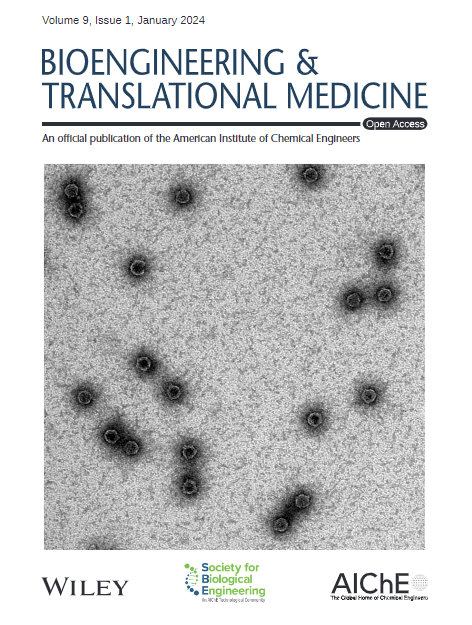Hypoxia‐preconditioned MiotEVs from bone marrow mesenchymal stem cells inhibit myocardial infarction‐induced cardiac fibrosis
IF 6.1
2区 医学
Q1 ENGINEERING, BIOMEDICAL
引用次数: 0
Abstract
Hypoxia‐preconditioned bone marrow mesenchymal stem cell‐derived mitochondrial extracellular vesicles (Hypoxia‐BMSC MitoEVs) emerged as a novel therapeutic candidate for myocardial infarction (MI)‐induced cardiac fibrosis. Here, we demonstrate that MitoEVs isolated from hypoxic BMSCs, rich in intact mitochondria and the RNA‐binding protein Quaking (QKI), potently inhibited TGF‐来自骨髓间充质干细胞的缺氧预处理miotev抑制心肌梗死诱导的心脏纤维化
缺氧预处理骨髓间充质干细胞来源的线粒体细胞外囊泡(Hypoxia - BMSC MitoEVs)成为心肌梗死(MI)诱导的心脏纤维化的一种新的治疗候选者。在这里,我们证明了从缺氧骨髓间充质干细胞中分离出来的mitoev,富含完整的线粒体和RNA结合蛋白(QKI),通过抑制α‐SMA和胶原的表达,在体外有效地抑制TGF‐β1驱动的肌成纤维细胞活化,同时恢复线粒体氧化磷酸化和代谢平衡。在小鼠心肌梗死模型中,全身输送缺氧- BMSC mitoev可减轻心肌纤维化,减少梗死面积,并改善左心室功能。线粒体ATP合酶在mitoev中的药理抑制同样降低了它们的治疗效果。从机制上讲,mitoev将QKI蛋白传递到心脏成纤维细胞,通过m7G修饰的RNA相互作用抑制纤维化mrna的翻译。在骨髓间充质干细胞中基因消融QKI可消除MitoEV介导的体外和体内抗纤维化作用,证实QKI是一个关键效应因子。这些结果表明,QKI驱动的翻译抑制和线粒体生物能量学都是其抗纤维化作用的基础。这些发现强调了缺氧- BMSC mitoev作为缓解心肌梗死后纤维化的治疗策略,值得进一步探索临床转化。
本文章由计算机程序翻译,如有差异,请以英文原文为准。
求助全文
约1分钟内获得全文
求助全文
来源期刊

Bioengineering & Translational Medicine
Pharmacology, Toxicology and Pharmaceutics-Pharmaceutical Science
CiteScore
8.40
自引率
4.10%
发文量
150
审稿时长
12 weeks
期刊介绍:
Bioengineering & Translational Medicine, an official, peer-reviewed online open-access journal of the American Institute of Chemical Engineers (AIChE) and the Society for Biological Engineering (SBE), focuses on how chemical and biological engineering approaches drive innovative technologies and solutions that impact clinical practice and commercial healthcare products.
 求助内容:
求助内容: 应助结果提醒方式:
应助结果提醒方式:


